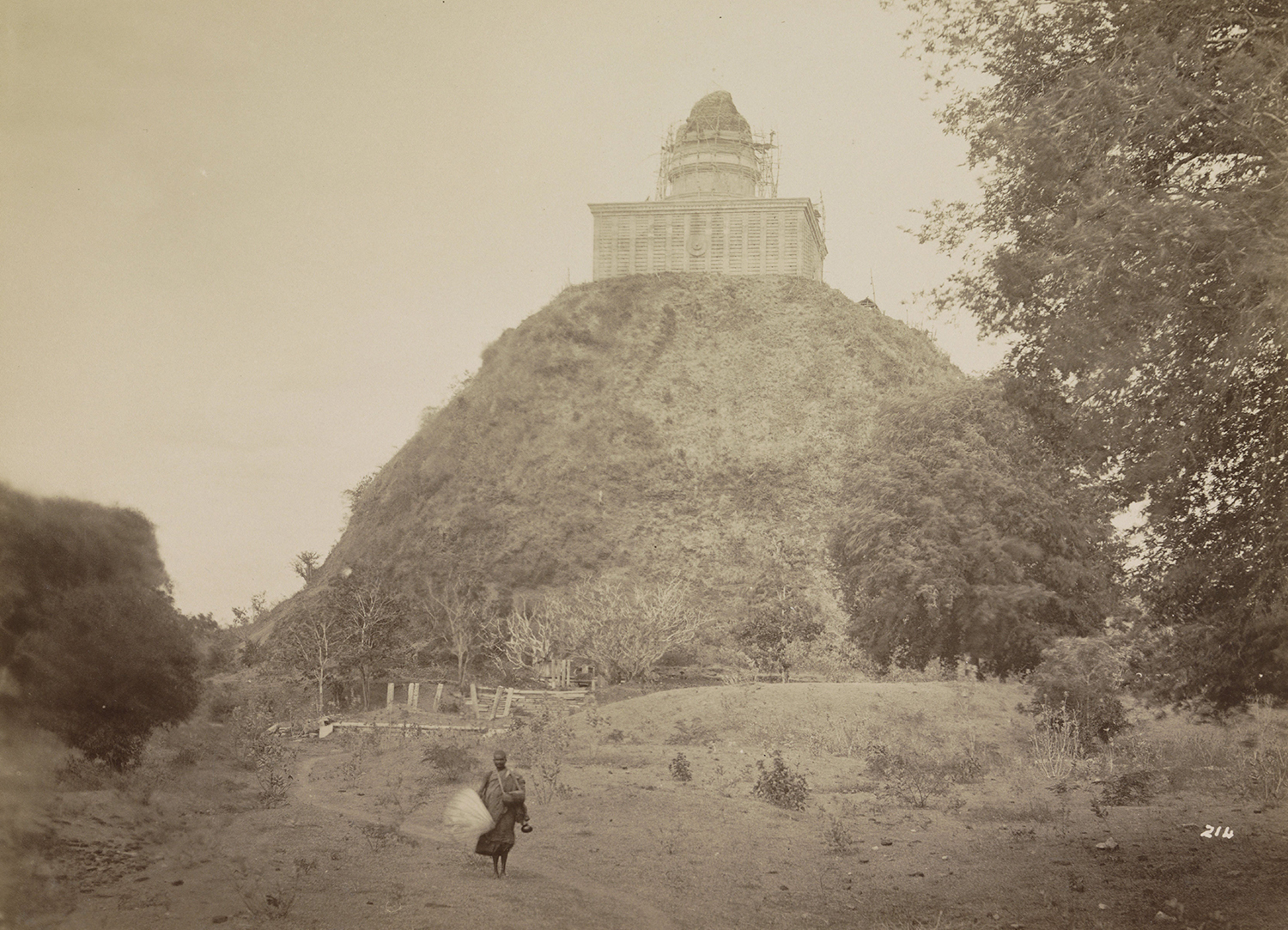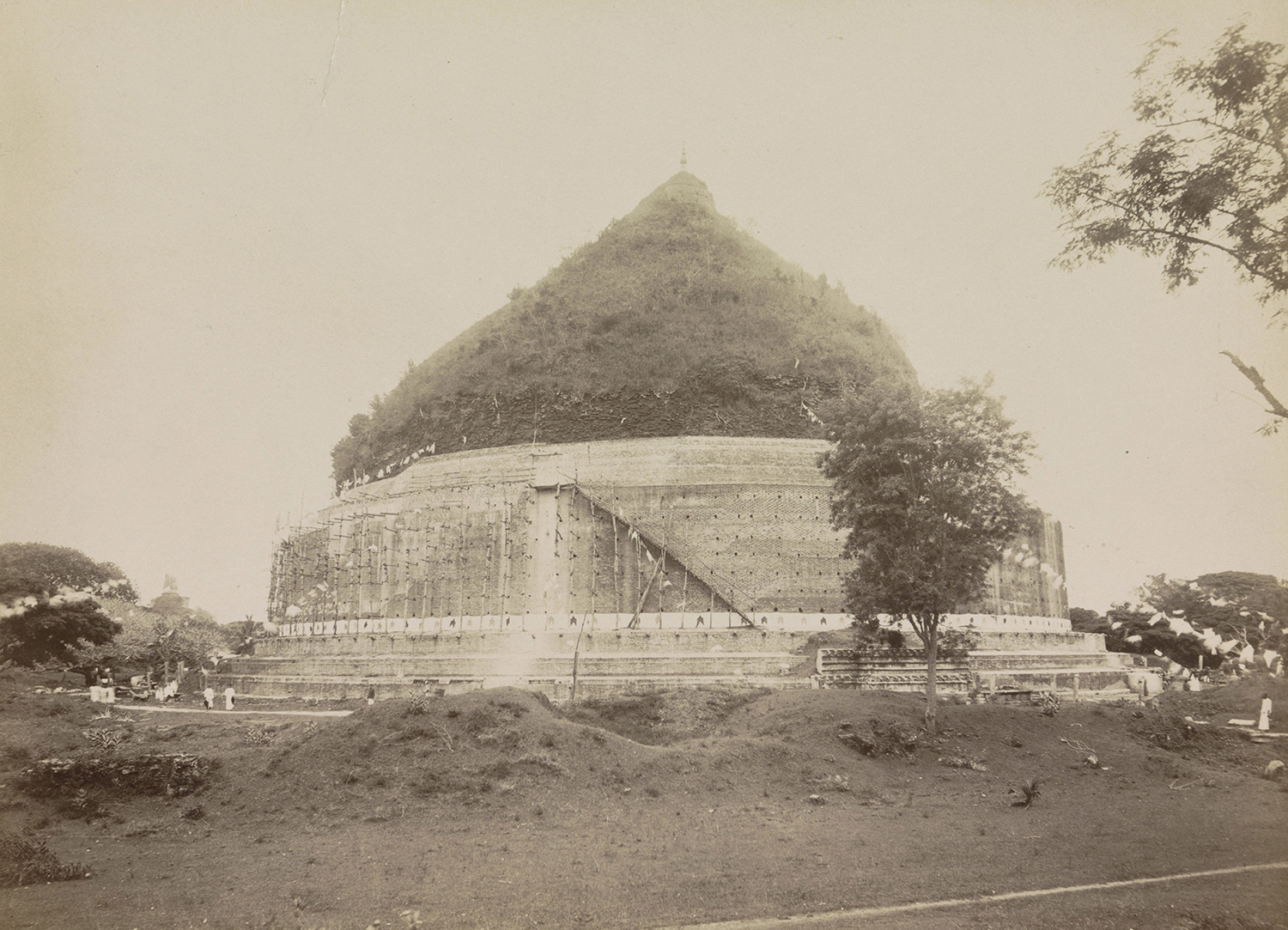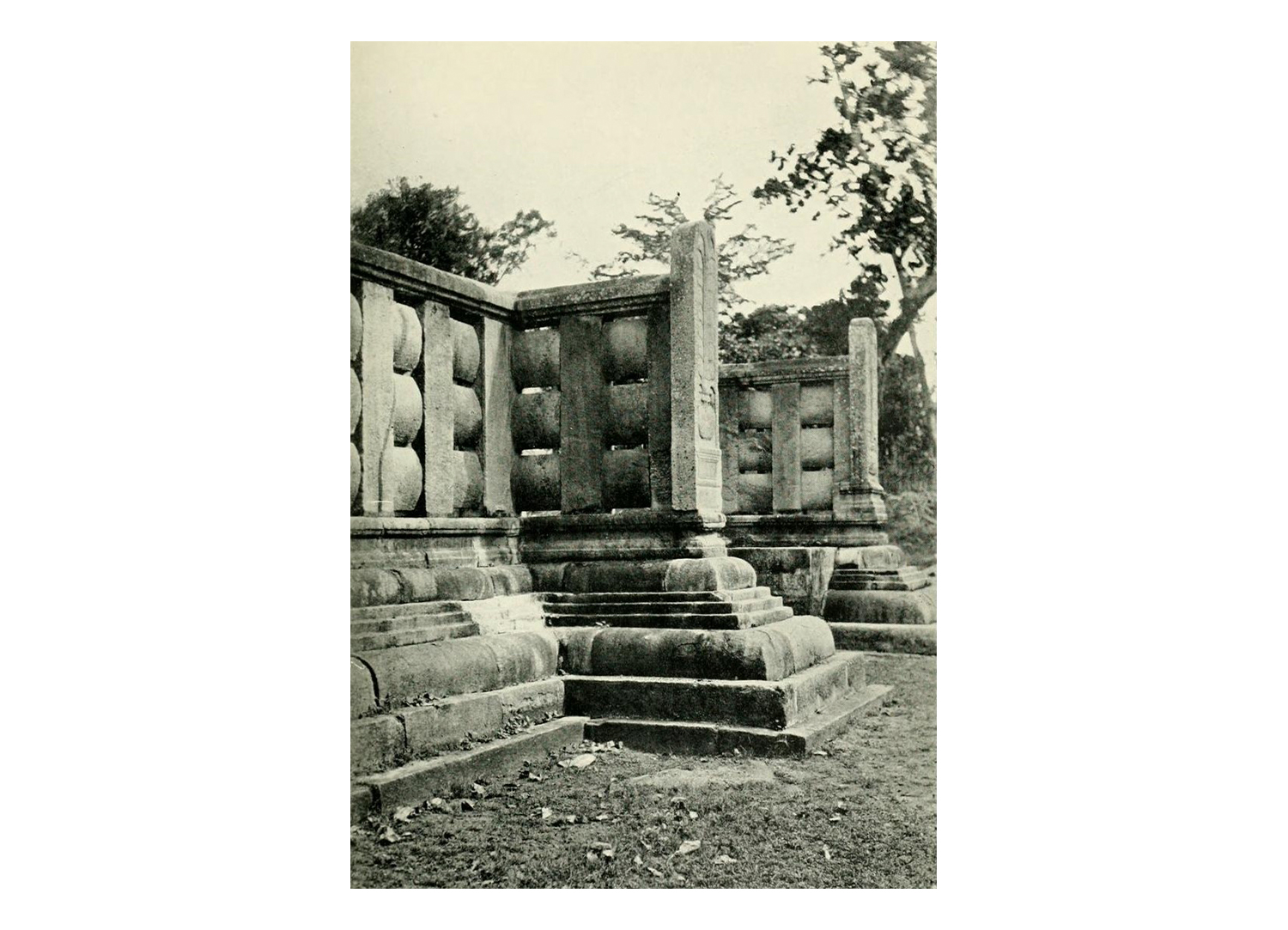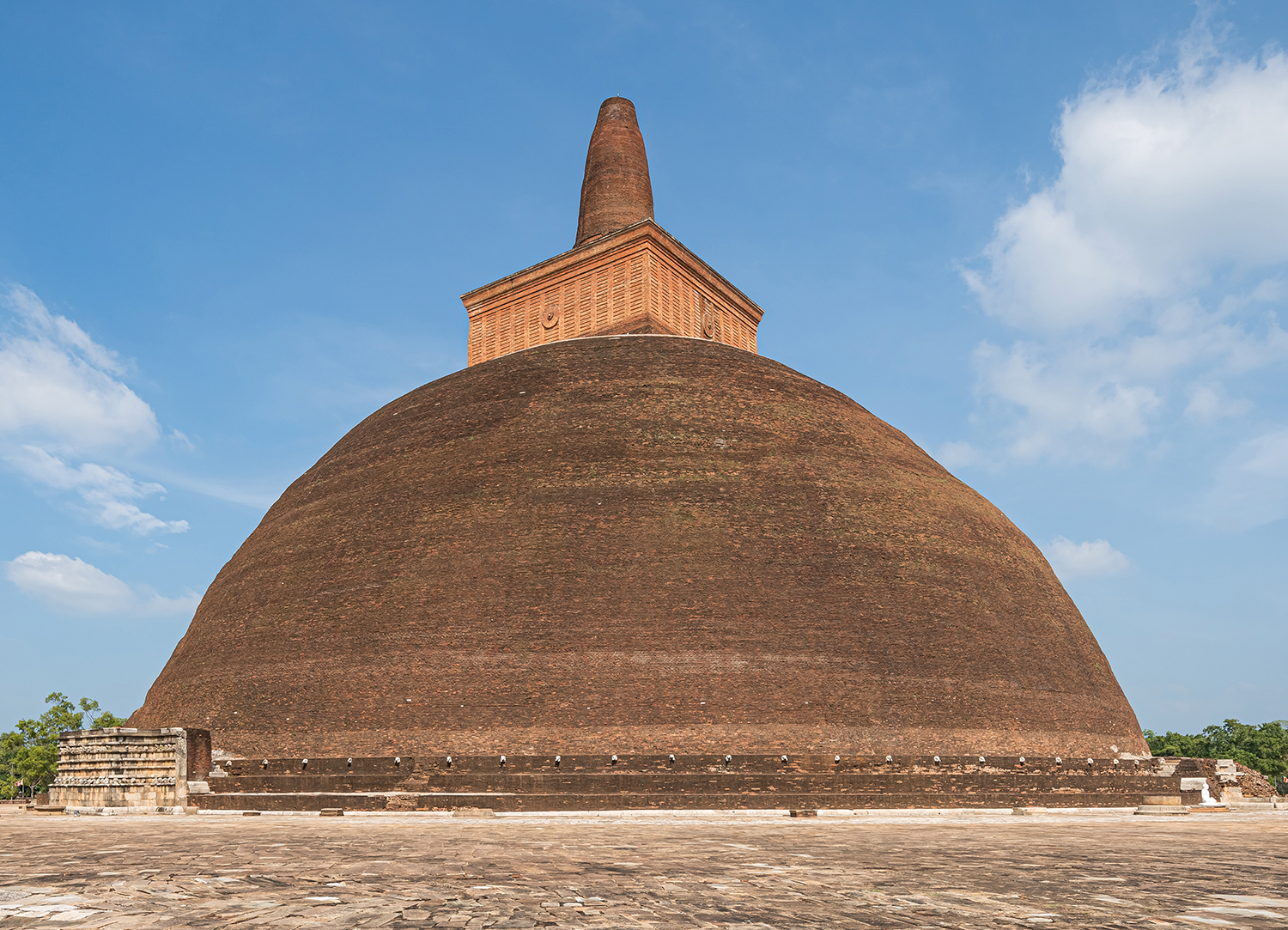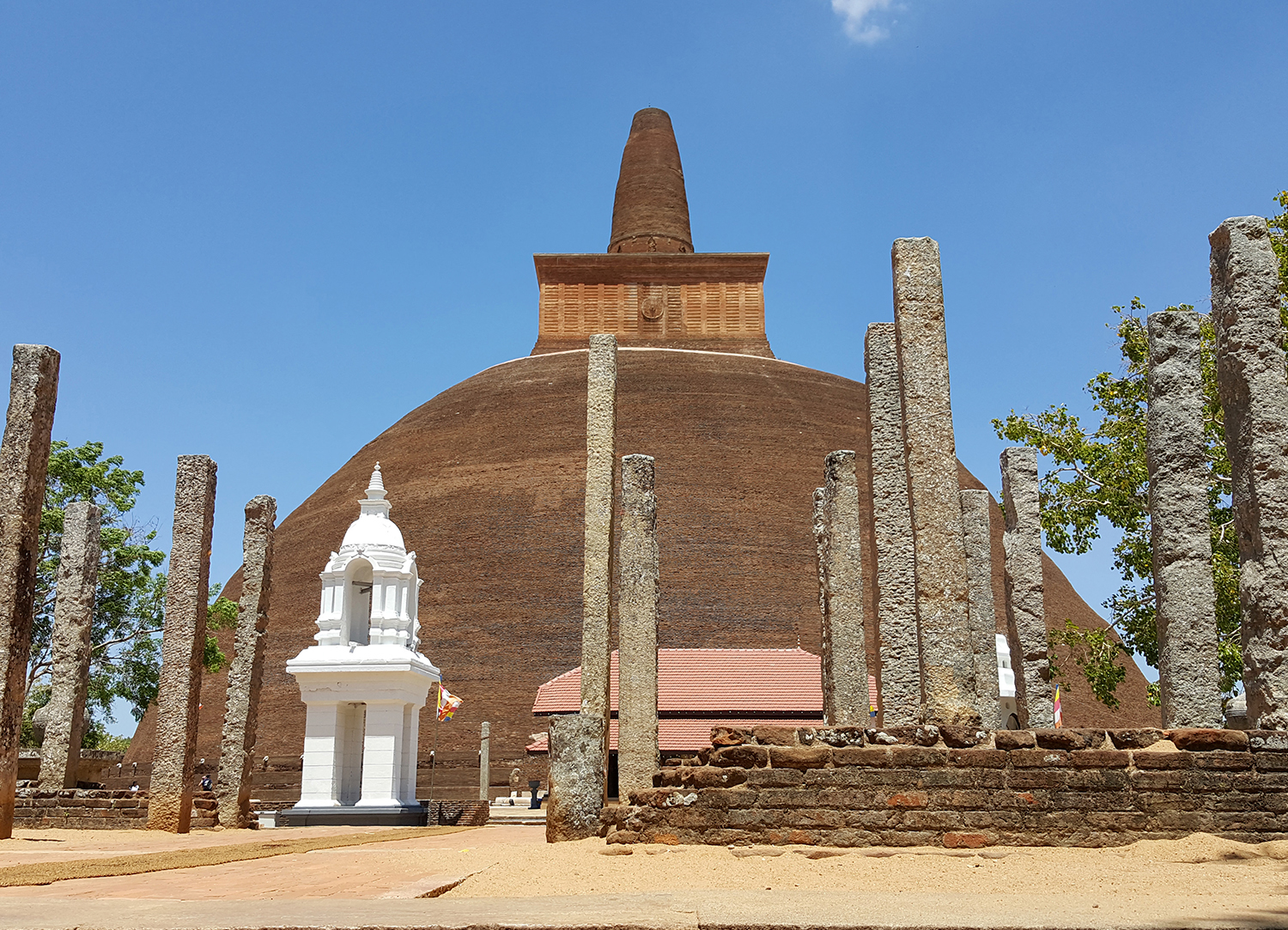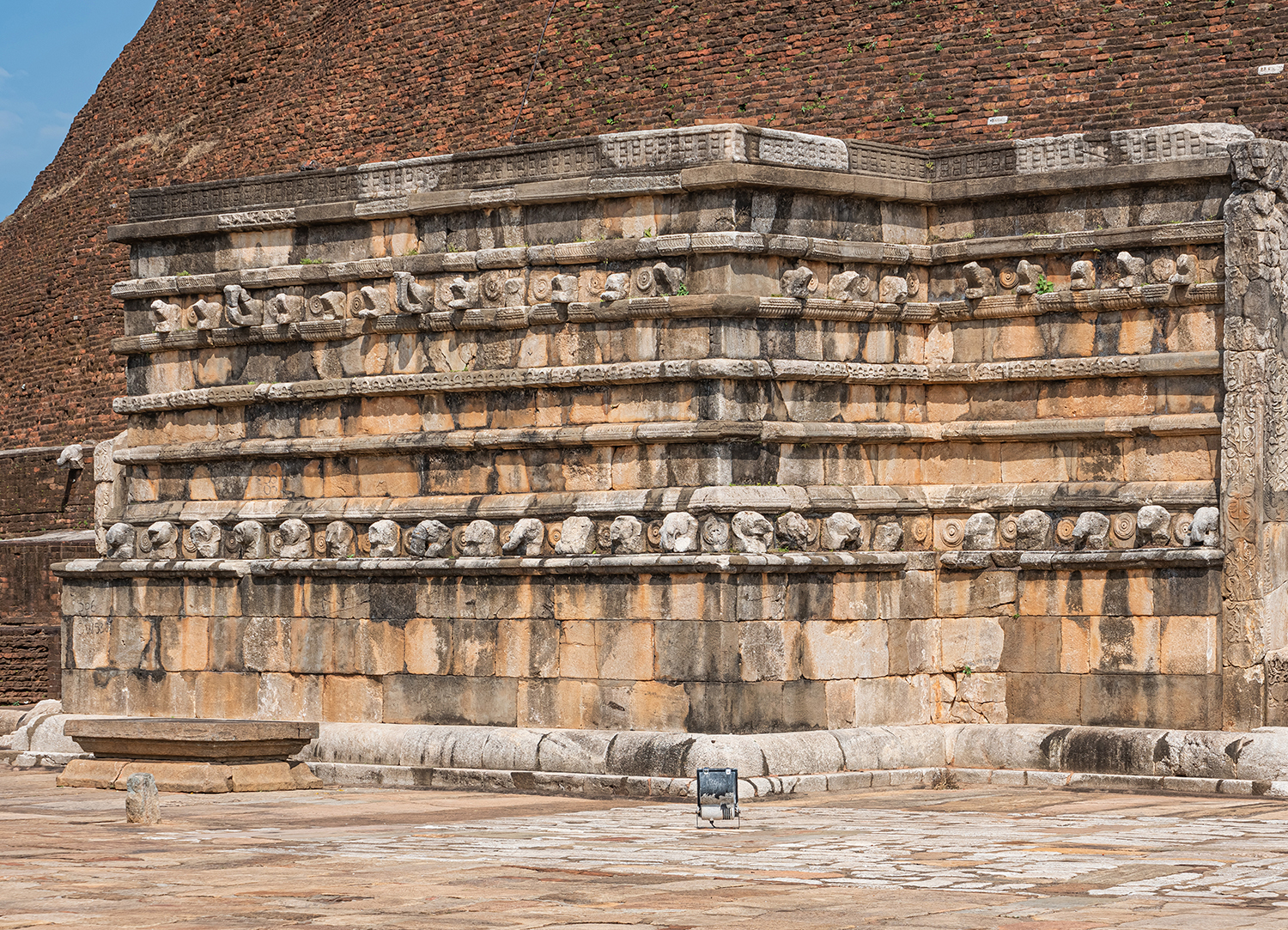ARTICLE
Abhayagiri Vihara, Anuradhapura
A prominent Buddhist monastic complex in Sri Lanka’s former capital Anuradhapura, Abhayagiri Vihara dates to the first century BCE. Located in the country’s North Central Province, the vihara is named after its founder, the king Vattagamani Abhaya (also called Valagamba), and is also known as Uttara Vihara or ‘Northern Monastery’. Diverging from the region’s monolithic Theravada Buddhist tradition of the time, the vihara came to embody progressive principles and a new school of Buddhism in Sri Lanka, which also incorporated Mahayana and Vajrayana thought. It developed networks with similar institutions overseas in China, Java and India, and became the first institution in Sri Lanka to house the relic of the Buddha’s Tooth. The Abhayagiri complex is centred around one of Anuradhapura’s largest dagobas — as stupas are known in Sinhala — the Abhayagiri Dagoba.
According to popular belief, the ruler of the Sinhala kingdom of Anuradhapura, Vattagamani Abhaya, established the vihara in fulfilment of a vow he had made fourteen years before he returned to power. The dates for his reign vary between two versions in scholarly accounts — while some accounts claim he first inherited the throne in 43 BCE and returned to power in 29–17 BCE, later scholarship claims the dates 103 and 89–77 BCE respectively.
Only months after first coming to power, Vattagamani was forced to flee and seek refuge in the mountains when Anuradhapura was besieged by invading Tamil forces from South India. While escaping, he is said to have passed by a Jain (or possibly Hindu) temple, set up by his predecessor Pandukabhaya, where he was insulted by the temple’s chief for abandoning his kingdom. Incensed, Vattagamani resolved to destroy the temple and build a Buddhist vihara in its place when he returned to Anuradhapura. Over the next fourteen years, he gathered armies in order to reclaim his kingdom, which was weakening under the successive reigns of five Tamil kings, as well as drought and the years-long famine known as Beminitya Seya. In 89 (or 29) BCE, Vattagamani successfully recaptured Anuradhapura, having defeated the last of these kings, and soon fulfilled his promise to replace the temple with a vihara. Whilst the complex was named partially after Vattagamani Abhaya himself, scholarship is divided on the second part of its name, with some accounts suggesting it refers to Giri, supposedly the name of either the razed temple or its chief. Others attribute it to the common tradition of suffixing monastery names with ‘giri’ (‘hillock’ in Sinhala), although Abhayagiri is among those Sri Lankan monasteries that have been established in a grove rather than on a hill.
Initially the vihara functioned along the lines of the Mahavihara monastery in Anuradhapura, established two centuries previously by the king Devanampiya Tissa. This prominent Theravada centre was a long-established seat of religious and political power in the kingdom. However, Abhayagiri diverged from the Mahavihara’s orthodox principles over time, and evolved as a distinct and cosmopolitan centre of Buddhist thought in Sri Lanka. The first of these rifts occurred when Vattagamani offered Abhayagiri to a thera or monk named Mahatissa, who, with another thera named Tissa, is said to have united his generals and kept them from defecting from his army during the Tamil siege. As viharas were seen as communal property belonging to the larger monastic community or sangha, a personal gift like this was unprecedented. Vattagamani’s generals further showed their indebtedness to Tissa by commissioning five viharas in the complex. Threatened by Mahatissa’s appointment at Abhayagiri, the Mahavihara establishment expelled him from the sangha on grounds of contact with laypeople, which they believed violated the code of the Vinaya-Pitaka. In protest, a large number of monks from Mahavihara also migrated to Abhayagiri, causing a considerable rift in the sangha and marking the start of Abhayagiri’s independent development.
Abhayagiri Vihara’s philosophical differences with Mahavihara deepened after it hosted the disciples of Dhammaruchi, an Indian teacher of the Vajjiputtaka sect whose progressive and unorthodox principles of conduct appealed to Tissa and his disciples. Over the next two centuries, the entire monastery of Abhayagiri is said to have come under the influence of Dhammaruchi and his doctrine of Vaitulyavada or Mahayanism. Cleaved into two different schools of monasticism, the two monasteries — Mahavihara and Abhayagiri Vihara — contested for autonomy over Buddhism in Sri Lanka. They diverged on issues such as monks’ acceptance of wealth, and canonical literature such as the Vaitulya Pitaka, which was followed at Abhayagiri but considered unorthodox and inappropriate by the Mahavihara. The Abhayagiri sect continued to establish contact with monastic orders overseas and thereby gained royal patronage abroad. Its robust links with Mahayana schools and with India led to Abhayagiri Vihara receiving and housing the relic of the Buddha’s Tooth, which arrived from Kalinga in India in the fourth century CE.
The written records of Faxian — a Chinese monk who went on pilgrimage to Abhayagiri in 412 CE — mention the procession of the Tooth relic towards the monastery. At this time, according to his notes, Abhayagiri Vihara accommodated about five thousand monks and was a leading centre of the Mahayana doctrine. According to the accounts of Xuanzang (c. 600–664 CE), the monks of Abhayagiri Vihara were not formally Mahayanist in their principles, but rather preached a hybrid of Theravada and Mahayana doctrines.
Meanwhile, the Mahavihara monastery was beginning to lose importance. The king Mahasena (r. 334–361 CE) is said to have stopped his people from giving alms to it and to have had its buildings dismantled and their materials used for structures at Abhayagiri. While many accounts describe continuing antagonism and sectarian conflict between Abhayagiri and Mahavihara until 1165 — when the two institutions are said to have settled their differences at a conference held in Anuradhapura — others scholars discount any narratives of conflict after the third century. By the seventh century, the Abhayagiri Vihara, already an important centre of monasticism, accommodated four sects of religious instruction known as mulas. These were the Uttara-mula — the most prominent fraternity tasked with the custodianship of the sacred Tooth relic — the Kapara-mula, the Mahanethpa-mula and the Vahadu-mula.
Today the 2-square-kilometre Abhayagiri complex stands mostly in ruins, with the exception of the dagoba, which has been restored and maintained. Forming the vihara’s ritual centre, the dagoba is a massive bell-shaped structure reaching a height of 120 metres, with a circumference of about 350 metres at its widest. Built primarily out of brick and lime mortar, the dome or anda stands on a square plinth made of stone and bounded by a parapet. Four entrances are built into the plinth, one at each of the cardinal points, with a guard house in front of each. The dagoba also features frontispieces at the cardinal points, in the form of stone sculptures and stelae. The dome is crowned by a square harmika, known as a hataraskotuva in Sinhala, and a cylindrical spire called a devatakotuva.
The dagoba is surrounded by the ruins of various structures, identified as image houses, an assembly hall, subsidiary shrines, a chapter house, living quarters, refectories, roadways and a hall for ritual anointing. The complex also houses multiple smaller dagobas, of which the Silasobbhakandaka Cetiya and the Indikatu Seya are well known.
Several smaller refectories along with alms halls and water reservoirs populated Abhayagiri to provide for the monks living in the monasteries all across the complex. The residential quarters were lesser monasteries that came under the four mulas, built in the seventh century. Each of these consisted of five multi-storeyed buildings plotted in the form of a quincunx, or panchavasa, and accommodated a total of twenty-four students. The students’ quarters in the four corners of the panchavasa housed three students on each floor. The central building of each complex was equipped with a library as well as an image of the Buddha; it was meant for the teacher and was used for pedagogical purposes. The lower floor of these structures was made of brick and lime mortar and reinforced with stone pillars, and the upper floors were made of timber plastered with lime. The roofs were layered with terracotta tiles that may have been made in the Abhayagiri complex itself, as indicated by pottery workshops identified in the vicinity. Each of the residential complexes was equipped with drainage and water facilities, septic tanks and a dining hall.
Structures once used as meeting halls for each of the four mulas have been identified in the complex. These were multi-storeyed chapter houses or uposathagharas, of which the best known is the ratnaprasadaya or Jewel Mansion, which stands to the west of the dagoba. While there is debate around the structure’s function — some sources have referred to it as an elephant stable — it is known to have been used primarily for uposatha ceremonies whereby monks and worshippers alike purged themselves of their transgressions and deliberately deepened their commitment to the Buddha’s teachings. An inscription from the tenth century states that the ratnaprasadaya was once made up of five storeys. The structure was accessed through an entryway guarded by a stone image of a Naga king with a hooded serpentine crown like a halo, holding a pot of abundance, or purnaghata, and flowers. According to some scholars the ratnaprasadaya was used for public events like the exhibition of the Tooth relic.
A congregation hall used for preaching, known as a sannipatasala, and considered to be the largest hall in the complex, is located in front of the dagoba’s southern entrance. Its remains suggest an open-air hall bound by a low stone parapet, and four entrances located at the cardinal points. One of these has revealed an image identified by scholars to be either Nagaraja — the King of Nagas, or Virupaksha — the Guardian of the Western Direction. It is presently housed in the Abhayagiri Museum.
Another significant structure in the Abhayagiri complex is the abhisheka mandapa or Anointing Pavilion situated to the south of the dagoba, the ruins of which comprise a stepped entrance, designated areas believed to hold water vessels and drains to empty water. The mandapa is said to have been used to anoint and consecrate statues of the Buddha and other bodhisattvas with scented water, and has been classified as a snanaghara or bathing house.
Stone slabs with protective sutras in the Nagari script — a precursor of Devanagari that was used for writing Sanskrit and Prakrit — have been found in the remains of a brick and stone structure to the east of the dagoba. Two moon stones (sandakada pahana) have been found at the complex, one at Mahasena’s Palace and the other at the Queen’s Pavilion. A recurring feature at many Sri Lankan Buddhist shrines, the moon stone is an intricately carved semi-circular slab of stone placed at entrances or the foot of staircases, representing the Buddhist samsara.
On the southwestern side of the dagoba stand the ruins of a large room that Faxian described as a dining room for the monks of Abhayagiri. This is evidenced by a large stone-clad trough that was used to either store or serve rice, with an estimated capacity to feed more than five thousand resident monks. A sundial, two courtyards, a dining area, hearths, grinding stones and underground channels were also found at the site.
Although archaeologists have been unable to identify the structure, Faxian’s records describe a principal hall of worship that enshrined a Buddha image more than 6 metres tall. Depicting the Buddha holding a pearl necklace, the image is described as being composed primarily of green jade and adorned with precious materials including gold, silver and gemstones. Some Sinhalese accounts mention an image house set up by Mahasena containing an image of the Buddha dating to the third century BCE. While some scholars consider this to be the oldest representation of the Buddha, no tangible evidence of the image exists. According to the Mahavamsa, the king Devanampiya Tissa commissioned a stone image for Thuparamaya — said to be Sri Lanka’s oldest Buddhist shrine — which was finally moved to Abhayagiri, where Buddhadasa endowed it with jewels for eyes. Dhatusena (r. c. 460–478 CE) replaced the jewels after they were lost, and added a halo, a crest and blue jewelled studs to the statue’s hair, and the queen of Sena II (r. c. 850–885 CE) crowned it with a blue jewel-encrusted headpiece. The shrine that housed the image was repaired by various royal patrons.
Abhayagiri Vihara houses a type of subsidiary shrine known as a bodhighara or Bodhi tree shrine. According to Faxian, Sanghamitta, an Indian nun, brought saplings of the sacred Bodhi tree — considered a representation of the Buddha’s enlightenment — to Sri Lanka and planted them at Abhayagiri. Patrons subsequently set up shrines near the trees, in the form of aediculae, which housed iconic images of the Buddha seated in the samadhi posture, as well as aniconic images of his footprints. The ruins of a number of such shrines have been identified based on excavations of Buddha statues, which are thought to have marked the corners of the bodhighara sites. One such statue is made of dolomite and is believed to have once been painted and studded with gemstones in its eye sockets. It is dated to before the third century CE, and is reminiscent of sculptures from the time of Gupta rule in India. Some of these statues are now housed in the Anuradhapura Archaeological Museum.
Water was supplied to the various parts of the complex through reservoirs and tanks located in the vicinity of the living quarters. Two rectangular ponds, known as the Twin Ponds or kuttam pokuna, are situated to the far east of the dagoba and are believed to have supplied water to the Kapara-mula. Thought to have been built in the sixth or seventh century CE under Aggabodhi I, the ponds feature inclined inner walls clad in polished stone with shallow ridges. At least one of the ponds was fed through a stone spout, and features a silt trap to filter the incoming water. At each of their four entrances are two large, sculpted pot-like motifs known as punkalas, which denote abundance; nearby is a sculpted stone slab that depicts a hooded cobra, Naga, known in Indic mythology for its association with water. A naga is also found depicted on a stone slab near the Elephant Pond or eth pokuna located within the complex. Considered to be the biggest artificial tank in Sri Lanka, the 159 x 53 metre reservoir has a depth of 10 metres and is fed through underground channels. A sluice constructed at its inlet to slow the inflow of water from the channels suggests that this was the chief water source feeding the other tanks in the complex.
Like many other Sri Lankan viharas, Abhayagiri Vihara is described by scholars as an organic monastery, the result of contributions made over several centuries, without a preconceived plan, in order to suit the growing needs of its residents. The vihara saw significant development in the second century CE under Gajabahu I (r. 114–136 CE), and continued to be patronised by a number of successive rulers. The dagoba underwent repairs and additions particularly in the fifth century by rulers such as Mittasena (r. 435–436) who built an entrance to it, and Dhatusena who commissioned repairs to its pinnacle area. The Kapara-mula was set up by the king Dhatopatissa II (r. 659–667 CE) and the Uttara-mula by Manavamma (r. 684–718 CE). The structures were augmented by other rulers including Aggabodhi IV (r. 673–689 CE) and Sena I (r. 846–866 CE). An image house adjoining the main structure was commissioned by the daughter of King Vijaybahu (r. 1055–1110).
Apart from prominent royal donors, the site also received patronage from other figures belonging to monasteries and from the people of the region. Several structures such as wells, water tanks, residential quarters, assembly halls, were constructed organically from endowments by individual patrons belonging to a variety of backgrounds. Faxian, observing the preparations underway for the public procession of the Tooth relic in the Abhayagiri complex, noted that the levelling and maintenance of roadways was widely believed to be a means of securing religious and spiritual merit.
Sri Lanka was again attacked by armies from South India during the ninth century, particularly those of the Chola rulers. Abhayagiri Vihara underwent significant destruction during this time, and fell into a state of neglect with the onset of Chola rule. The invaders also attacked the dagoba in search of a rumoured treasure at its core, leading it to collapse to under 75 metres, from its 121-metre height in Faxian’s records. Anuradhapura was replaced by Polonnaruwa as the capital of the kingdom, and the Abhayagiri site was abandoned in the thirteenth century after the kings Vijayabahu I and Parakramabahu I had made repeated attempts to reinstate it to its former glory. The complex was largely forgotten for the next several centuries, until it began to receive attention in the nineteenth century.
In 1828–29, the clearing of the vegetal growth on the surface of the dagoba to protect it from further destruction caused the collapse of the structure’s cylindrical spire. In 1882, the western side of the structure caved in; in the same decade, the site became the centre of newfound interest, and the colonial dispensation in Sri Lanka undertook efforts to survey and restore it. During restoration work in 1887, colonial officers bored a passage through the core of the dagoba and discovered votive donations inside. Between the years 1910 and 1912, the Department of Archaeology reinforced the crowning features of the dagoba, and in 1926, monks initiated efforts to restore the structure’s base terraces.
In 2015, the Abhayagiri Dagoba was opened to the public after a comprehensive fifteen-year-long conservation and restoration project by the Sri Lankan Central Cultural Fund under the oversight of the UNESCO.
Bibliography
Ching, Francis D. K., Mark Jarzombek, and Vikramaditya Prakash. A Global History of Architecture. Hoboken, New Jersey: Wiley, 2017.
Davis, C. E. “Early Buddhist Monasteries in Sri Lanka: A Landscape Approach.” PhD diss., Durham University, 2013.
Geiger, Wilhelm. Culture of Ceylon in Mediaeval Times. Edited by Heinz Bechert. Wiesbaden: Otto Harrassowitz, 1960.
Harischandra, W. The Sacred City of Anuradhapura. New Delhi: Asian Educational Services, 1985. First published 1904 by Anuradhapura Maha-Bodhi Society.
Keown, Damien. A Dictionary of Buddhism. 1st ed. Oxford University Press, 2004. https://doi.org/10.1093/acref/9780198605607.001.0001.
Rahula, Walpola. History of Buddhism in Ceylon. Colombo: M D Gunasena and Co. Ltd., 1966.




